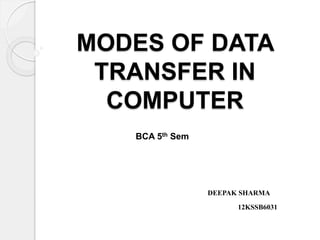10.data transmission
- 1. MODES OF DATA TRANSFER IN COMPUTER BCA 5th Sem DEEPAK SHARMA 12KSSB6031
- 2. TOPIC DATA TRANSMISSION TYPES
- 3. DATA TRANSMISSION Data transmission refers to the movement of data in form of bits between two or more digital devices. This transfer of data takes place and some form of transmission media.
- 4. DATA TRANSMISSION TYPES 1. Parallel 2. Serial (i) Synchronous (ii) Asynchronous
- 5. PARALLEL TRANSMISSION In parallel transmission, all the bits of data are transmitted simultaneously on separate communication lines. Parallel transmission is used for short distance communication. In order to transmit n bit , n wires or lines are used. More costly. Faster than serial transmission. Data can be transmitted in less time.
- 6. SERIAL TRANSMISSION In serial transmission , the various bits of data are transmitted serially one after the other. It requires only one communication line rather than n lines to transmit data from sender to receiver. Thus all the bits of data are transmitted on single lines in serial fashion. Less costly. Long distance transmission.
- 7. SYNCHRONOUS TRANSMISSION Data sent at one time multiple bytes. Start and stop bit not used. Gap between data units not present. Data transmission speed fast. Cost high. Transfer of data between two computer. Synchronization between sender and receiver required.
- 8. ASYNCHORONOUS TRANSMISSION Sends only one character at a time (one byte of data at a time) Synchronize two devices using Start Bit and Stop Bit. Start bit refers to the start of the data. Usually 0 is used for start bit. Stop bit indicates the end of data.more than one bit can be used for end.
- 9. TRANSMISSION MODE The term transmission mode defines the direction of the flow of information between two communication devices i .e It tells the direction of signal flow between the two devices.
- 10. TYPES OF TRANSMISSION MODE 1. Simplex Transmission Mode. 2. Half Duplex Transmission Mode 3. Full Duplex Transmission Mode.
- 11. SIMPLEX MODE In simplex mode transmission information sent in only one direction. Device connected in simplex mode is either sent only or received only that is one device can only send, other device can only receive. Communication is unidirectional. I
- 12. HALF DUPLEX In half duplex transmission data can be sent in both the directions, but only in one direction at a time. Both the connected device can transmit and receive but not simultaneously. When one device is sending the other can only receive and vice-versa.
- 13. FULL DUPLEX In full duplex transmission, data can be sent in both the directions simultaneously. Both the connected devices can transmit and receive at the same time. Therefore it represents truly bi-directional system. In full duplex mode, signals going in either Direction share the full capacity of link.
- 14. THANK YOU

